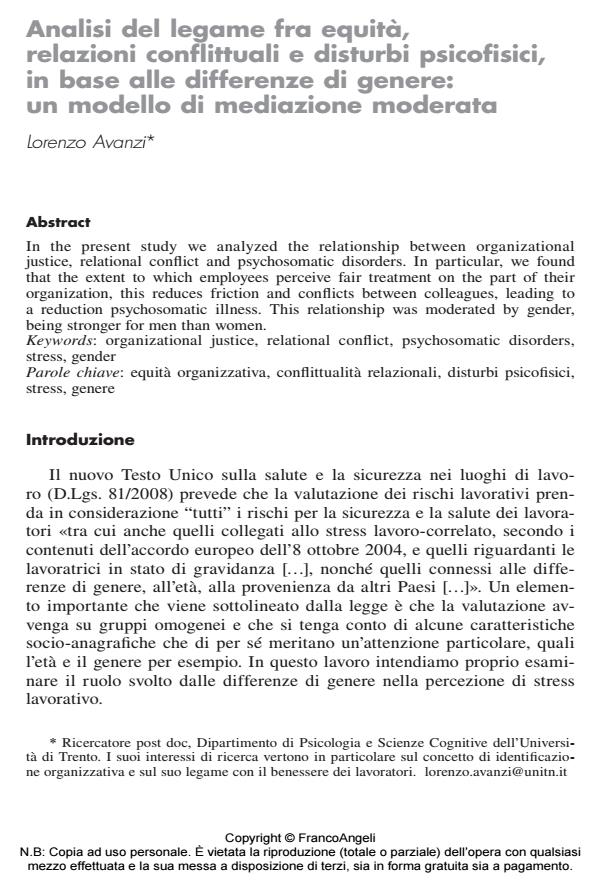Analisi del legame fra equità, relazioni conflittuali e disturbi psicofisici, in base alle differenze di genere: un modello di mediazione moderata
Journal title SICUREZZA E SCIENZE SOCIALI
Author/s Lorenzo Avanzi
Publishing Year 2015 Issue 2015/1 Language Italian
Pages 12 P. 149-160 File size 113 KB
DOI 10.3280/SISS2015-001012
DOI is like a bar code for intellectual property: to have more infomation
click here
Below, you can see the article first page
If you want to buy this article in PDF format, you can do it, following the instructions to buy download credits

FrancoAngeli is member of Publishers International Linking Association, Inc (PILA), a not-for-profit association which run the CrossRef service enabling links to and from online scholarly content.
In the present study we analyzed the relationship between organizational justice, relational conflict and psychosomatic disorders. In particular, we found that the extent to which employees perceive fair treatment on the part of their organization, this reduces friction and conflicts between colleagues, leading to a reduction psychosomatic illness. This relationship was moderated by gender, being stronger for men than women.
Keywords: Organizational justice, relational conflict, psychosomatic disorders, stress, gender
- Avallone F., Paplomatas A. (2005). Salute Organizzativa. Psicologia del benessere nei contesti lavorativi. Milano: Raffaello Cortina.
- CohenCharash Y., Spector P.E. (2001). The Role of Justice in organizations: A metaanalysis. Organizational Behavior and Human Decision Processes, 86: 278-321. DOI: 10.1006/obhd.2001.2958
- Davis M.C., Matthews K.A., Twamley E.W. (1999). Is life more difficult on Mars or Venus? A metaanalytic review of sex differences in major and minor life events. Annals of Behavioral Medicine, 21: 83-97. DOI: 10.1007/BF02895038
- De Dreu C.K.W., Weingart L.R. (2003). Task versus relationship conflict, team performance, and team member satisfaction: A meta-analysis. Journal of Applied Psychology, 88: 741-749. DOI: 10.1037/00219010.88.4.741
- Elovainio M., Heponiemi T., Sinervo T., Magnavita N. (2010). Organizational justice and health; review of evidence. Giornale Italiano di Medicina del Lavoro ed Ergonomia Supplemento B, Psicologia, 32: B5-B9.
- Fraccaroli F., Balducci C. (2012). Stress e rischi psicosociali nelle organizzazioni. Bologna: il Mulino.
- Hayes A.F. (2013). An introduction to mediation, moderation, and conditional process analysis: A regressionbased approach. New York: Guilford Press. http://www.guilford.com.
- Matud M.P. (2004). Gender differences in stress and coping styles. Personality and Individual Differences, 37: 1401-1415. doi :10.1016/j.paid.2004.01.010.
- Nielsen M.B., Einarsen S. (2012). Outcomes of exposure to workplace bullying: A meta-analytic review. Work & Stress: An International Journal of Work, Health & Organisations, 26: 309-332. DOI: 10.1080/02678373.2012.734709
- Tepper B.J. (2007). Abusive supervision in work organizations: Review, synthesis, and research agenda. Journal of Management, 33: 261-289. DOI: 10.1177/014920630730081
Lorenzo Avanzi, Analisi del legame fra equità, relazioni conflittuali e disturbi psicofisici, in base alle differenze di genere: un modello di mediazione moderata in "SICUREZZA E SCIENZE SOCIALI" 1/2015, pp 149-160, DOI: 10.3280/SISS2015-001012